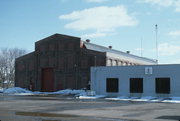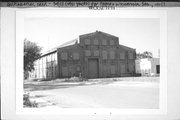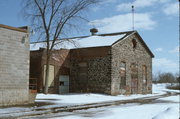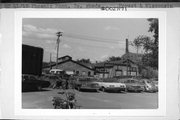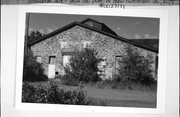| Additional Information: | A 'site file' exists for this property. It contains additional information such as correspondence, newspaper clippings, or historical information. It is a public record and may be viewed in person at the Wisconsin Historical Society, State Historic Preservation Office.
The Phoenix Manufacturing Company is situated on a five acre site located at the southwest corner of E. Madison Street and Forest Street in the northern portion of Eau Claire's central business area. The property is bounded on the west by the Chippewa River and on the south by land owned by the Chicago, Milwaukee & St. Paul Railroad.
Two of the five interconnected buildings comprising the property are of stone construction, the various-sized blocks laid in courses with heavily mortared joints. These side-by-side structures are oriented east-west and form the southern section of the complex. The most southern of the two - the nearly square building which formerly housed the company's foundry facilities - is covered by a broad gable roof. Several rectangular openings pierce the walls of the building but nearly all of these have been covered by either concrete blocks or wood. The remaining intact window is on the south side and it is filled with a multi-paned light. On the east facade, six windows and a large garage-like entrance are evident. The windows are marked by stone lintels and sills and the large entry by a segmental arch formed by bricks (the arch appears to be a later addition). A round window, now boarded over, is within the gable. This feature is repeated on the west wall of the building and on both gable ends of the neighboring structure. The openings on the south and west facades are emphasized by wooden lintels and sills.
Attached on the north (The buildings were probably joined when the brick structure was built in 1907) is a narrow rectangular similarly designed structure, originally containing the machine shop.) The 1897 Sanborn Perris Map shows this building as also extending north where the brick structure now stands.) The window openings (once again all have been blocked in) are highlighted by brick segmental arches and, in most cases, by stone sills. Large door openings have been added to the building, altering the fenestration pattern.
Connected to the north wall of the first machine shop is the immense reddish-brick structure which replaced it. Measuring 200 ft. by 93 ft., the building is identified by its monitor roof. The slanting sides of the upper portion of the roof are glazed to allow light to enter the center of the structure. The long east wall of the building is filled with two rows of paired segmental arched windows. (All of the building's windows have been boarded over.). The broad openings are accented by narrow stone sills and on the second story by a pattern of brick corbelling. On the north wall the same window openings are visible as well as a large entrance which originally allowed railroad cars to enter the building. A brick boiler room, also constructed in 1907, is attached at the southwest corner of the building. At the west side of the machine shop is a concrete block addition, erected in the mid-twentieth century, which is not considered significant to the nomination. The shop is steel framed and on the interior divided into galleries, twenty-four feet wide, supported by pillars.
In a December, 1981 report prepared by the City of Eau Claire, who now owns the building, the stone structures were listed in poor condition; the 1907 brick structure in average condition, with the remodeling or repair work done up to this point confined to the replacement of windows, roof, and doors.
The Phoenix Manufacturing Company, three contiguous structures located on a five acre site on the east bank of the Chippewa River, is an architecturally significant property, providing the city's most intact example of industrial architecture. Although the structures have been altered as the result of changing industrial needs, the original architectural quality of the buildings remains and records the development of one of Eau Claire's principle industrial firms. The two stone structures, initially used as the firm's foundry and machine shop, represent a method of construction and illustrate a type of structure used by manufacturing concerns in the nineteenth century. The massive brick structure characterized by a monitor roof and large segmental arch openings, both features providing light to the interior work area.
The Phoenix Manufacturing Company, one of the city's oldest manufacturing firms, is a historically significant property in Eau Claire, representing the sawmill machinery and logging equipment industry that developed in conjunction with the city's vast lumber-milling activities. The successor of the company Graham and Tolles organized in 1861, the Phoenix firm was probably best known for the production of the Phoenix log hauler, a "huge machine resembling a conventional steam engine with tank treads" (C). The log hauler, which revolutionized the lumber transportation process, enabled lumbermen to haul larger loads and to enter and log previously inaccessible stands of timber. This product as well as the company's line of traditional sawmill machinery brought the Phoenix name into every lumber producing state and several foreign countries.
The firm of Graham and Tolles, the forerunner of the Phoenix Manufacturing Company was founded in 1861 by Hiram P. Graham, a millwright, and his brother-in-law, Robert Tolles, a machinist. The company included a planing mill, foundry, and machine shop and specialized in building and repairing sawmill machinery. Following a fire in 1875 the business that had originally occupied land on the north bank of the Eau Claire River west of Dewey Street moved to the present site at Forest and Wisconsin Streets. In the same year the firm was incorporated under the name of the Phoenix Manufacturing Company with a capital stock of $50,000.
In the next decades the Phoenix Manufacturing Company produced a number of new products for the lumber milling industry. In 1887 a new band-type mill known as the Esplin Mill was placed on the market followed by the Emerson and the Phoenix band mills (D). The firm also furnished building parts such as arches, plates, and columns. Many structures in the city feature slim support columns marked with the Phoenix name. In 1892 a separate division, the Phoenix Furniture Company, was organized and located in a building on the city's westside (E).
The company's greatest contribution came in the early twentieth century (1903) when, under the patent rights of Orlando Lombard, it produced a steam log hauler. The revolutionary machine was perfected by Charles Tolles, the son of one of the company's founders, and first used by Eau Claire's Northwestern Lumber Company. One report stated: "Where previously the average load of logs to be pulled by a team of horses was one sled and a load of between five and ten thousand board feet, now 125,000 board feet and up to 25 sleds were being pulled by one hauler..." (C). The company ultimately produced over one hundred of the machines, some of which were sent to Alaska, Finland, and Canada.
Following the development of the log hauler, the company expanded physically. A large brick machine shop was erected in 1907 and the stone buildings which had contained the foundry and first machine shop were converted to warehouses. At its height of operation, the Phoenix complex consisted of twenty one frame, brick, and stone buildings covering the five acre site. A railroad spur with a side track that entered the machine shop was part of the property.
Although the future of the steam log hauler seemed bright, the combination of a depleted timber supply and the competition from the more efficient Holt gasoline powered hauler ended its usefulness. In response, the company moved to the production of a gas powered vehicle for farming and construction use. The Phoenix centipede truck went into production in 1905 (C).
Later in the twentieth century the firm experienced a number of financial setbacks arising from disputes over patent rights. These problems became so great that in 1925 the Phoenix Manufacturing Company was forced into bankruptcy, and subsequently purchased by the W.H. Hobbs Supply Company. Reopening under the name W.H. Hobbs Supply - Phoenix Division, the new company supplied materials for the construction industry including steel beams, reinforcing wire, sheet metal, and ornamental steel.
In 1951 Louis L. Phillips assumed control of the Phoenix Division and an independent corporation, the Phoenix Steel Corporation, was formed. This company used the property until 1976 when it was purchased by the Landy Packing Company for warehouse use. In 1980 Paul Bearson bought the site and leased out portions of the buildings to various companies, primarily for warehouse space but also for small manufacturing.
Currently the City of Eau Claire owns the property. Purchased in 1981, the buildings are being used by a number of business concerns whose leases expire by 1985. After an extensive analysis, the city of Eau Claire's Department of Planning and Development filed the following recommendation for the property:
"Having analyzed the various alternative uses of the site, the recommended course of action for the city to pursue is to demolish the structures in 1985 and redevelop the site according to a site plan which emphasizes open space-recreational use of the property. Consideration should be given to retaining one or both portions of the structure built in 1875 (the original foundry and machine shop) if the use and appearance of these sections can economically and functionally serve the future use of the site. If, prior to 1985, the private sector were to clearly demonstrate that adaptive reuse is feasible and that a rehabilitation project can be successfully completed, the city should consider that option as well" (F). |
|---|

